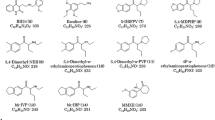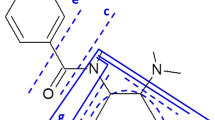Abstract
Eutylone is a cathinone-derived synthetic amphetamine scheduled by the World Health Organization and European Monitoring Centre for Drugs and Drug Addiction since 2022 due to its growing consumption. We report here an eutylone intoxication involving a 38-year-old man and a 29-year-old woman in a chemsex context. A bag containing a white crystalline powder labelled as a research product was found in their vehicle. Nuclear magnetic resonance and liquid chromatography-high-resolution mass spectrometry (LC-HRMS) analyses identified the powder as eutylone and confirmed purity superior to 99%. LC-HRMS data analysis using molecular networking allowed to propose new eutylone metabolites in blood samples in a graphical manner. We described 16 phase I (e.g. hydroxylated or demethylated) and phase II metabolites (glucuroconjugates and sulfoconjugates). The same metabolites were found both in male and female blood samples. Toxicological analyses measured eutylone concentration in blood samples at 1374 ng/mL and 1536 ng/mL for the man and the woman, respectively. A keto-reduced metabolite (m/z 238.144) was synthesized to permit its quantification at 67 ng/mL and 54 ng/mL in male and female blood samples, respectively. Overall, the identification of these metabolites will increase the knowledge of potential drug consumption markers and allow to implement mass spectrometry databases to better monitor future drug abuse or consumption.



Similar content being viewed by others
Data availability
Datas are available in supplementary figures.
References
Allard S, Allard P-M, Morel I, Gicquel T (2019) Application of a molecular networking approach for clinical and forensic toxicology exemplified in three cases involving 3-MeO-PCP, doxylamine, and chlormequat. Drug Test Anal 11:669–677. https://doi.org/10.1002/dta.2550
Allard S, Le Daré B, Allard P-M et al (2020) Comparative molecular networking analysis of a Rauwolfia plant powder and biological matrices in a fatal ingestion case. Forensic Toxicol 38:447–454. https://doi.org/10.1007/s11419-020-00531-0
Ameline A, Garnier D, Gheddar L et al (2019) Identification and analytical characterization of seven NPS, by combination of 1H NMR spectroscopy, GC-MS and UPLC-MS/MS®, to resolve a complex toxicological fatal case. Forensic Sci Int 298:140–148. https://doi.org/10.1016/j.forsciint.2019.03.003
Arrêté du 22 février 1990 fixant la liste des substances classées comme stupéfiants
Batisse A, Eiden C, Deheul S et al (2022) Chemsex practice in France: an update in addictovigilance data. Fund Clin Pharmacol 36:397–404. https://doi.org/10.1111/fcp.12725
Bottinelli C, Revelut K, Hologne M et al (2019) GC-MS, GC-QTOF and NMR analyses to elucidate composition of 41 powders from an NPS collector. Toxicologie Analytique et Clinique 31:275–282. https://doi.org/10.1016/j.toxac.2019.10.002
Cartiser N, Sahy A, Advenier A-S et al (2021) Fatal intoxication involving 4-methylpentedrone (4-MPD) in a context of chemsex. Forensic Sci Int 319:110659. https://doi.org/10.1016/j.forsciint.2020.110659
Chen H-Y, Chien W-C, Huang M-N et al (2021) Analytically confirmed eutylone (bk-EBDB) exposure in emergency department patients. Clin Toxicol (Phila) 59:846–848. https://doi.org/10.1080/15563650.2020.1868491
European Monitoring Centre for Drugs and Drug Addiction (2022) European drug report 2022: trends and developments. Publications Office, LU
European Monitoring Centre for Drugs and Drug Addiction (EU body or agency), Europol (EU body or agency) (2015) EMCDDA–Europol 2014 annual report on the implementation of Council Decision 2005/387/JHA. In: accordance with Article 10 of Council Decision 2005/387/JHA on the information exchange, risk assessment and control of new psychoactive substances: implementation reports. Publications Office of the European Union, LU
Eutylone critical review report. https://www.who.int/publications/m/item/eutylone-critical-review-report. Accessed 30 Sep 2022
Gicquel T, Pelletier R, Richeval C et al (2021a) Metabolite elucidation of 2-fluoro-deschloroketamine (2F-DCK) using molecular networking across three complementary in vitro and in vivo models. Drug Test Anal. https://doi.org/10.1002/dta.3162
Gicquel T, Richeval C, Mesli V et al (2021b) Fatal intoxication related to two new arylcyclohexylamine derivatives (2F-DCK and 3-MeO-PCE). Forensic Sci Int 324:110852. https://doi.org/10.1016/j.forsciint.2021.110852
Glatfelter GC, Walther D, Evans-Brown M, Baumann MH (2021) Eutylone and its structural isomers interact with monoamine transporters and induce locomotor stimulation. ACS Chem Neurosci 12:1170–1177. https://doi.org/10.1021/acschemneuro.0c00797
Hays PA (2005) Proton nuclear magnetic resonance spectroscopy (NMR) methods for determining the purity of reference drug standards and illicit forensic drug seizures. J Forensic Sci 50:1342–1360
Kernalléguen A, Le Daré B, Pelletier R et al (2022) Carbofuran self-poisoning: forensic and analytic investigations in twins and literature review. Int J Legal Med 136:1585–1596. https://doi.org/10.1007/s00414-022-02885-z
Krotulski AJ, Mohr ALA, Papsun DM, Logan BK (2018a) Dibutylone (bk-DMBDB): intoxications, quantitative confirmations and metabolism in authentic biological specimens. J Anal Toxicol 42:437–445. https://doi.org/10.1093/jat/bky022
Krotulski AJ, Papsun DM, De Martinis BS et al (2018b) N-ethyl pentylone (ephylone) intoxications: quantitative confirmation and metabolite identification in authentic human biological specimens. J Anal Toxicol 42:467–475. https://doi.org/10.1093/jat/bky025
Krotulski AJ, Papsun DM, Chronister CW et al (2021) Eutylone intoxications-an emerging synthetic stimulant in forensic investigations. J Anal Toxicol 45:8–20. https://doi.org/10.1093/jat/bkaa113
Kuropka P, Zawadzki M, Szpot P (2023) A review of synthetic cathinones emerging in recent years (2019–2022). Forensic Toxicol 41:25–46. https://doi.org/10.1007/s11419-022-00639-5
Le Daré B, Ferron P-J, Allard P-M et al (2020a) New insights into quetiapine metabolism using molecular networking. Sci Rep 10:19921. https://doi.org/10.1038/s41598-020-77106-x
Le Daré B, Allard S, Bouvet R et al (2020b) A case of fatal acebutolol poisoning: an illustration of the potential of molecular networking. Int J Legal Med 134:251–256. https://doi.org/10.1007/s00414-019-02062-9
Le Daré B, Ferron P-J, Allard P-M et al (2020c) New insights into quetiapine metabolism using molecular networking. Sci Rep 10:19921. https://doi.org/10.1038/s41598-020-77106-x
Malandain L, Mosser S, Mouchabac S et al (2021) Chemical sex (chemsex) in a population of French university students. Dialogues Clin Neurosci 23:39–43. https://doi.org/10.1080/19585969.2022.2042163
Meyer MR, Wilhelm J, Peters FT, Maurer HH (2010) Beta-keto amphetamines: studies on the metabolism of the designer drug mephedrone and toxicological detection of mephedrone, butylone, and methylone in urine using gas chromatography–mass spectrometry. Anal Bioanal Chem 397:1225–1233. https://doi.org/10.1007/s00216-010-3636-5
Nakamura M, Takaso M, Takeda A, Hitosugi M (2022) A fatal case of intoxication from a single use of eutylone: clinical symptoms and quantitative analysis results. Leg Med 58:102085. https://doi.org/10.1016/j.legalmed.2022.102085
NFLIS-Drug (2020) Annual Report and Drug Midyear Report. 36
Pieprzyca E, Skowronek R, Nižnanský Ľ, Czekaj P (2020) Synthetic cathinones—from natural plant stimulant to new drug of abuse. Eur J Pharmacol 875:173012. https://doi.org/10.1016/j.ejphar.2020.173012
Wang M, Carver JJ, Phelan VV et al (2016) Sharing and community curation of mass spectrometry data with global natural products social molecular networking. Nat Biotechnol 34:828–837. https://doi.org/10.1038/nbt.3597
Yeh Y-L, Wang S-M (2022) Quantitative determination and metabolic profiling of synthetic cathinone eutylone in vitro and in urine samples by liquid chromatography tandem quadrupole time-of-flight mass spectrometry. Drug Test Anal 14:1325–1337. https://doi.org/10.1002/dta.3258
Acknowledgements
This project was supported by financial allowance “Défi Scientifique” Université Rennes 1.
Author information
Authors and Affiliations
Contributions
Conceptualization: PR, LBD, LDB, FP-J, PF-H, GT; methodology: LBD, LDB, PR, FP-J, GT; Formal analysis and investigation: all authors; writing—original draft preparation: PR, LBD, PFH, LDB, TG; writing—review and editing: all authors; supervision: Gicquel Thomas.
Corresponding author
Ethics declarations
Conflict of interest
The authors declare no conflict of interest. The funders had no role in the design of the study; in the collection, analyses, or interpretation of data; in the writing of the manuscript, or in the decision to publish the results.
Ethical standards
The study was conducted according to the guidelines of the Declaration of Helsinki, and approved by the Ethics Committee of University Hospital of Rennes.
Additional information
Publisher's Note
Springer Nature remains neutral with regard to jurisdictional claims in published maps and institutional affiliations.
Supplementary Information
Below is the link to the electronic supplementary material.
Rights and permissions
Springer Nature or its licensor (e.g. a society or other partner) holds exclusive rights to this article under a publishing agreement with the author(s) or other rightsholder(s); author self-archiving of the accepted manuscript version of this article is solely governed by the terms of such publishing agreement and applicable law.
About this article
Cite this article
Pelletier, R., Le Daré, B., Le Bouëdec, D. et al. Identification, synthesis and quantification of eutylone consumption markers in a chemsex context. Arch Toxicol 98, 151–158 (2024). https://doi.org/10.1007/s00204-023-03615-z
Received:
Accepted:
Published:
Issue Date:
DOI: https://doi.org/10.1007/s00204-023-03615-z




